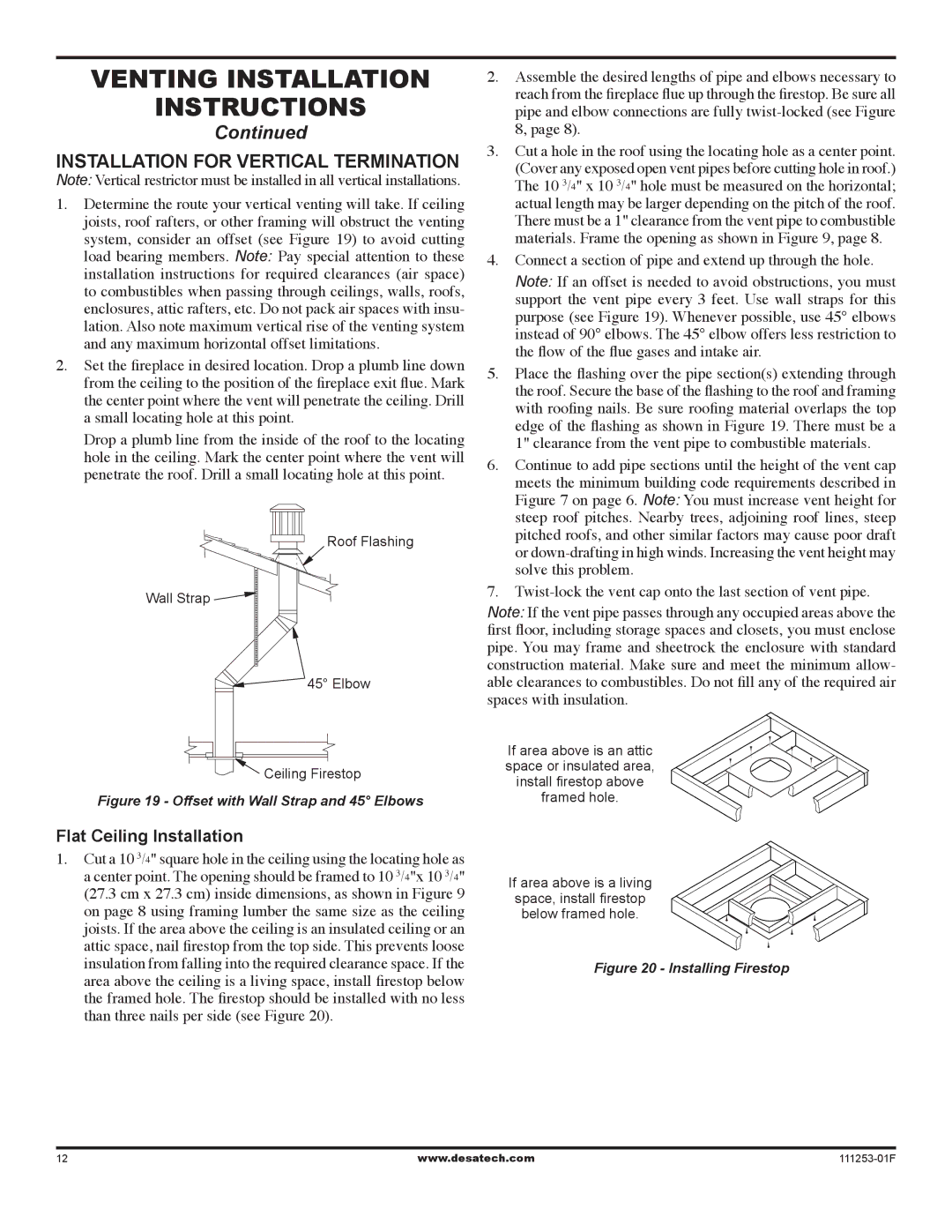
Venting Installation
instructions
Continued
installation for vertical termination Note: Vertical restrictor must be installed in all vertical installations.
1.Determine the route your vertical venting will take. If ceiling joists, roof rafters, or other framing will obstruct the venting system, consider an offset (see Figure 19) to avoid cutting load bearing members. Note: Pay special attention to these installation instructions for required clearances (air space) to combustibles when passing through ceilings, walls, roofs, enclosures, attic rafters, etc. Do not pack air spaces with insu- lation. Also note maximum vertical rise of the venting system and any maximum horizontal offset limitations.
2.Set the fireplace in desired location. Drop a plumb line down from the ceiling to the position of the fireplace exit flue. Mark the center point where the vent will penetrate the ceiling. Drill a small locating hole at this point.
Drop a plumb line from the inside of the roof to the locating hole in the ceiling. Mark the center point where the vent will penetrate the roof. Drill a small locating hole at this point.
Roof Flashing
Wall Strap ![]()
![]() 45° Elbow
45° Elbow
![]() Ceiling Firestop
Ceiling Firestop
Figure 19 - Offset with Wall Strap and 45° Elbows
Flat Ceiling Installation
1.Cut a 10 3/4" square hole in the ceiling using the locating hole as a center point. The opening should be framed to 10 3/4"x 10 3/4" (27.3 cm x 27.3 cm) inside dimensions, as shown in Figure 9 on page 8 using framing lumber the same size as the ceiling joists. If the area above the ceiling is an insulated ceiling or an attic space, nail firestop from the top side. This prevents loose insulation from falling into the required clearance space. If the area above the ceiling is a living space, install firestop below the framed hole. The firestop should be installed with no less than three nails per side (see Figure 20).
2.Assemble the desired lengths of pipe and elbows necessary to reach from the fireplace flue up through the firestop. Be sure all pipe and elbow connections are fully
3.Cut a hole in the roof using the locating hole as a center point. (Cover any exposed open vent pipes before cutting hole in roof.) The 10 3/4" x 10 3/4" hole must be measured on the horizontal; actual length may be larger depending on the pitch of the roof. There must be a 1" clearance from the vent pipe to combustible materials. Frame the opening as shown in Figure 9, page 8.
4.Connect a section of pipe and extend up through the hole. Note: If an offset is needed to avoid obstructions, you must support the vent pipe every 3 feet. Use wall straps for this purpose (see Figure 19). Whenever possible, use 45° elbows instead of 90° elbows. The 45° elbow offers less restriction to the flow of the flue gases and intake air.
5.Place the flashing over the pipe section(s) extending through the roof. Secure the base of the flashing to the roof and framing with roofing nails. Be sure roofing material overlaps the top edge of the flashing as shown in Figure 19. There must be a 1" clearance from the vent pipe to combustible materials.
6.Continue to add pipe sections until the height of the vent cap meets the minimum building code requirements described in Figure 7 on page 6. Note: You must increase vent height for steep roof pitches. Nearby trees, adjoining roof lines, steep pitched roofs, and other similar factors may cause poor draft or
7.
Note: If the vent pipe passes through any occupied areas above the first floor, including storage spaces and closets, you must enclose pipe. You may frame and sheetrock the enclosure with standard construction material. Make sure and meet the minimum allow- able clearances to combustibles. Do not fill any of the required air spaces with insulation.
If area above is an attic space or insulated area, install firestop above framed hole.
If area above is a living space, install firestop below framed hole.
Figure 20 - Installing Firestop
12 | www.desatech.com |
